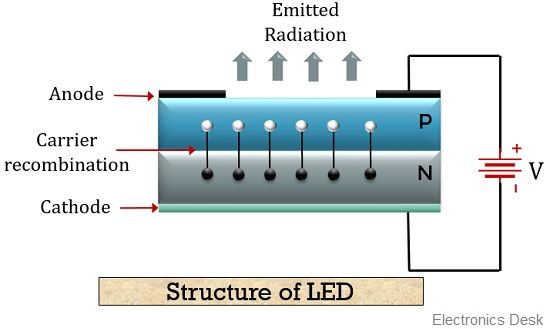One of the major differences between LED and photodiode is related to their operating principle. An LED is a device that works on the principle of electro-luminance. While the operation of a photodiode depends on the principle of photoconduction.
Basically when an external potential is provided then a light emitting diode gives off light. Whereas in photodiodes, some external light energy must be provided to allow conduction through the device.
In this article, you will get to know some other important differences between the two. But before proceeding towards that just have a look at the contents that are to be addressed under this article.
Content: LED Vs Photodiode
Comparison Chart
| Parameter | LED | Photodiode |
|---|---|---|
| Definition | LED is a device that converts electric energy into light energy. | Photodiode is a device that converts light energy into electric energy. |
| Symbol |  |  |
| Operating Principle | Electroluminance | Photoconduction |
| Function | It emits light. | It detects light. |
| Type of biasing | Forward biased | Reverse biased |
| Fabricated with | GaAs, GaAsP, GaP etc. | Si, InGaAs etc. |
| Leakage current | Not exist | Exist, and known as dark current. |
| Application | In electronic display system, light display system etc. | Solar panel, logic circuits etc. |
Definition of LED
LED is an acronym used for the light emitting diode. These are basically forward biased device that emits light when the external potential is provided to its terminals.
The working of an LED is based on the principle of electroluminance. When an external potential is provided then electron-hole recombination occurs. Due to this recombination, some energy is liberated either in the form of heat or light.
But in LEDs, the energy liberation occurs in the form of light. Due to this reason, these diodes hold the tendency to emit light.
Now, the question arises which factor decides the emission of light through the diode?
Basically, this depends on the semiconductor material used for the fabrication of diodes.
When diodes are fabricated with silicon or germanium material, then the recombination produces energy in the form of heat. Whereas, in the case of GaAsP or GaP materials, energy is emitted in the form of light.
The figure below represents the structure of the LED:

We know that in a forward biased condition, the holes present in p-side gets repelled by the positive battery terminal. And the electrons present in n side gets repelled by the negative battery terminal.
This repulsive force causes the holes and electrons to get recombined after overcoming the potential barrier.
More simply we can understand it by assuming the energy band diagram.
We know free electrons are present in the conduction band and this band is above the valence band. The valence band contains holes.
So, the electrons are present in higher energy state and to combine with the holes present in the lower energy state, they must give off some energy. And the materials like GaAsP or GaP gives off this energy in the form of light.
Hence the diode emits light due recombination of electrons and holes when the external potential is provided to it.
Definition of Photodiode
The name photodiode is itself suggesting its operation. We know photo means light so it is basically a device whose operation depends on the illumination provided to it.
A photodiode is a reverse biased diode as it operates in reverse mode. The figure here represents a reverse biased pn junction, showing a photodiode:

Here , in the above figure, we can see that the pn junction of the device is exposed to light.
We know that in reverse biased condition a wide depletion region exists at the pn junction. In the depletion region, neutral atoms are present as this region is depleted of the charge carriers.
Even when no external illumination is provided at the junction, then due to reverse applied potential minority carriers will flow and generate a reverse leakage current.
This current is known as the dark current.
But once the junction is supplied with external light then due to an increase in the junction temperature, the electron and hole present in the depletion region gets free. Thus their movement produces electric current.
With the rise in the intensity of the light provided, the junction temperature also increases. With the increase in the temperature, the generation of the electron-hole pair will also increase, which resultantly increase the current flowing through the device.
Key Differences Between LED and Photodiode
- An LED converts electrical energy applied into its terminals into equivalent light form. On the contrary, a photodiode is able to convert supplied light energy into equivalent electrical form.
- A light emitting diode operates in forward biased condition only. While a photodiode is basically a reverse biased diode.
- As LEDs are forward biased hence no leakage current exists in its case. Whereas, due to reverse applied voltage at the terminals of the photodiode, reverse leakage current flows, which is known as dark current.
- LEDs are fabricated with materials like gallium arsenide, gallium arsenide phosphide or gallium phosphide etc. As against, photodiodes are constructed with materials such as silicon, indium gallium arsenide etc.
- An LED is able to emit light but cannot detect it. However, a photodiode can detect light but cannot release it.
- LEDs majorly finds their applications in electronic display systems, lights in vehicles, in light indication system etc. Whereas photodiodes find their applications in solar panels, in logic circuits and television etc.
Conclusion
So, from the above discussion, we can conclude that though LED and photodiode both are types of diodes. But their operating principles are entirely different from each other. This is the reason the two finds applications in different fields.
Very explanatory